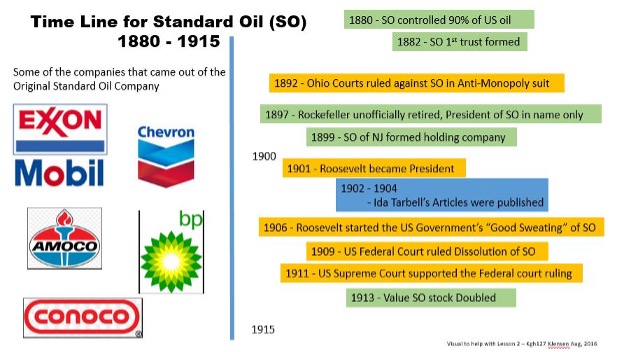The Prize, Chapter 5 Overview
All was not ideal as far as the general public was concerned. Rapid industrialization spawned big monopolies and giant companies. Society felt threatened and suspicious and called on the government to institute controls. Reminds us of today and big tech companies, does it not? That fear of “big oil” combined with a growth of progressivism set the government and Standard Oil on a collision course that would change the face of the industry forever. This fight was as much about socialism versus capitalism as it was about oil. Ida Tarbell’s mission to dismantle Standard Oil aligned with President Roosevelt’s belief that government need not destroy these monopolies and trusts, but should control them.
Standard Oil established a holding company, but that was not enough to insulate the company, and by 1906, the government filed a lawsuit, and in 1909, the dissolution was ordered. Interestingly, the dissolution of Standard Oil was the end of an era, and Rockefeller retired, but it also triggered a new movement. Out of the dissolution came forth a number of new smaller companies who today are great in their own right. But as we see today, over a century later, the market is still adjusting. At one time, Exxon and Mobil were powerhouses competing with each other, but now we know them as ExxonMobil. Some companies that came from Standard Oil have since disappeared.
The early 1900s was jampacked with new technology, new areas of development, new uses for the product, and a new relationship between government and big business. This dynamic relationship between government and big business exists to this day; and we see it with telecommunications, banking, technology, and others. Think of Twitter, Facebook and others.

| Year | Event |
|---|---|
| 1880 | SO Controlled 90% of US oil |
| 1882 | SO 1st trust formed |
| 1892 | Ohio Courts ruled against SO in an Anti-Monopoly suit |
| 1897 | Rockefeller unofficially retired, President of SO in name only |
| 1899 | SO of NJ formed a holding company |
| 1901 | Roosevelt became President |
| 1902-1904 | Ida Tarbell's Articles were published |
| 1906 | Roosevelt started the US Gov't's "Good Sweating" of SO |
| 1909 | US Federal Court ruled Dissolution of SO |
| 1911 | US Supreme Court supported the Federal court ruling |
| 1913 | Value SO stock Doubled |
The Prize, Chapter 5 - The Dragon Slain
Sections to Read
- Introduction
- The Holding Company
- "The Red Hot Event"
- Rockefeller's "Lady Friend"
- The Trust-Buster
- The Suit
- The Dissolution
- The Liberation of Technology
Questions to Guide Your Reading:
- What forces were contributing to declining market share by Standard?
- What happened to sow the roots of hatred against big oil?
- Who did the public seek as the ultimate check on monopoly power?
- What started to happen between politics & business?
